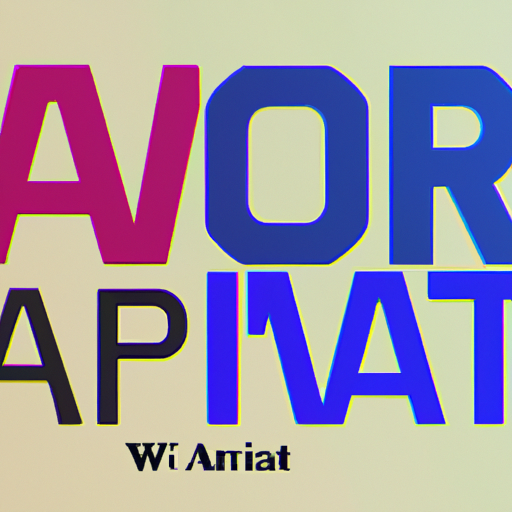
-
Table of Contents
- The Art of Typography: From Calligraphy to Digital Fonts
- The Origins of Typography: Calligraphy
- The Printing Press Revolution
- The Birth of Typeface Design
- The Digital Revolution and Typography
- The Impact of Typography on Design and Communication
- Case Studies: The Power of Typography
- The Future of Typography
- Key Takeaways
- Conclusion
The Art of Typography: From Calligraphy to Digital Fonts

Typography is the art and technique of arranging type to make written language legible, readable, and visually appealing. It has evolved over centuries, from the ancient art of calligraphy to the modern digital fonts we use today. In this article, we will explore the fascinating journey of typography, its impact on design and communication, and how it has adapted to the digital age.
The Origins of Typography: Calligraphy
Typography finds its roots in calligraphy, the ancient art of beautiful writing. Calligraphy originated in various cultures around the world, including China, Egypt, and Europe. It involved skilled scribes using brushes, quills, or reeds to create intricate and visually pleasing letterforms.
One of the most famous calligraphic scripts is the Gothic script, developed in the 12th century. Its ornate and elaborate style became synonymous with medieval manuscripts and religious texts. Calligraphy played a crucial role in preserving knowledge and disseminating information during the Middle Ages.
The Printing Press Revolution
The invention of the printing press by Johannes Gutenberg in the 15th century revolutionized the world of typography. The printing press allowed for the mass production of books, making them more accessible to the general public. Gutenberg’s movable type system enabled faster and more efficient typesetting, replacing the labor-intensive process of hand-copying manuscripts.
Gutenberg’s most famous work, the Gutenberg Bible, showcased the potential of typography in disseminating information. The book featured a consistent and legible typeface, setting a standard for future typographic design.
The Birth of Typeface Design
As printing technology advanced, the need for diverse and visually appealing typefaces grew. This led to the birth of typeface design, where designers created unique letterforms and styles. One of the most influential typeface designers was Claude Garamond, who developed the Garamond typeface in the 16th century. Garamond’s typeface is still widely used today and is known for its elegance and readability.
In the 18th century, the Industrial Revolution brought about significant changes in typography. The invention of the steam-powered press allowed for faster and more efficient printing. This led to the rise of newspaper printing, which required legible and space-saving typefaces. The Times New Roman typeface, designed for The Times newspaper in 1931, became a popular choice due to its readability in small sizes.
The Digital Revolution and Typography
The advent of computers and digital technology in the late 20th century revolutionized typography once again. Digital fonts replaced physical type, allowing for greater flexibility and ease of use. Designers could now experiment with a wide range of typefaces and customize them to suit their needs.
One of the most significant developments in digital typography was the introduction of TrueType fonts by Apple in the 1980s. TrueType fonts were scalable and could be displayed at any size without losing quality. This innovation paved the way for the widespread use of digital typography in various applications, from print to web design.
The Impact of Typography on Design and Communication
Typography plays a crucial role in design and communication. It sets the tone and mood of a piece, enhances readability, and guides the reader’s eye. The choice of typeface can convey different emotions and messages, whether it’s a bold and attention-grabbing headline or a subtle and elegant body text.
Good typography can also improve the user experience in digital interfaces. Well-designed and legible fonts make content more accessible and enjoyable to read. In contrast, poor typography can hinder comprehension and create a negative user experience.
Case Studies: The Power of Typography
Several case studies demonstrate the impact of typography on communication and branding. One notable example is the rebranding of Airbnb in 2014. The company redesigned its logo, opting for a custom typeface called “Airbnb Cereal.” The new typeface reflected the brand’s friendly and approachable image, contributing to its success and recognition.
Another case study is the Obama 2008 presidential campaign. The campaign’s use of the Gotham typeface, known for its clean and modern aesthetic, helped convey a sense of hope and change. The typography played a significant role in creating a cohesive and memorable visual identity for the campaign.
The Future of Typography
As technology continues to advance, typography will undoubtedly evolve further. Variable fonts, for example, are a recent development that allows for greater flexibility in type design. Variable fonts enable designers to adjust various attributes of a typeface, such as weight, width, and slant, in real-time.
Additionally, with the rise of augmented reality (AR) and virtual reality (VR), typography will play a crucial role in creating immersive and interactive experiences. Designers will have the opportunity to experiment with three-dimensional and animated typography, pushing the boundaries of traditional type design.
Key Takeaways
- Typography has evolved from calligraphy to digital fonts, adapting to changes in technology and design trends.
- The printing press revolutionized typography, making books more accessible and setting standards for legibility.
- Typeface design emerged as a distinct discipline, with influential designers shaping the evolution of typography.
- The digital revolution brought about new possibilities in typography, allowing for greater flexibility and customization.
- Typography plays a crucial role in design and communication, setting the tone and enhancing readability.
- Case studies demonstrate the impact of typography on branding and communication.
- The future of typography lies in advancements such as variable fonts and immersive experiences in AR and VR.
Conclusion
Typography is an art form that has evolved over centuries, from the intricate calligraphy of ancient civilizations to the digital fonts we use today. It has played a vital role in communication, design, and branding, shaping the way we perceive and interact with written language. As technology continues to advance, typography will continue to adapt and innovate, creating new possibilities for expression and communication.
